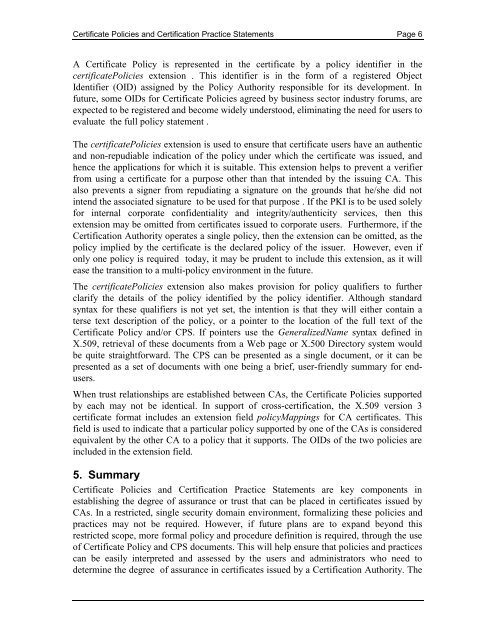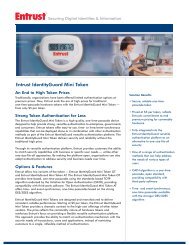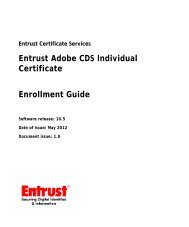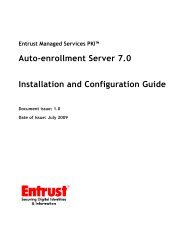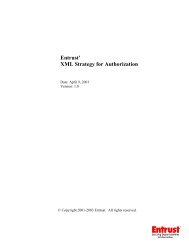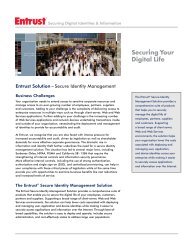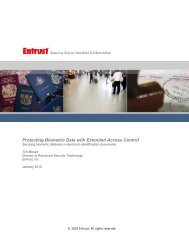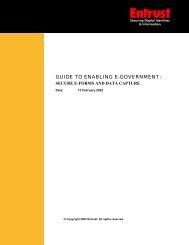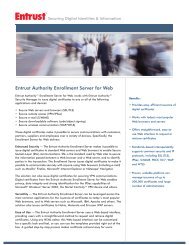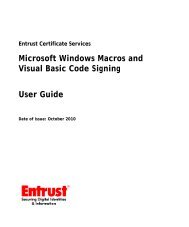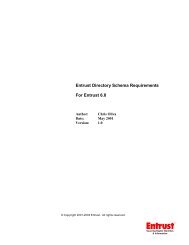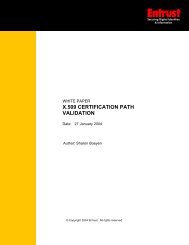Certificate Policies and Certification Practice Statements v.1.0 - Entrust
Certificate Policies and Certification Practice Statements v.1.0 - Entrust
Certificate Policies and Certification Practice Statements v.1.0 - Entrust
You also want an ePaper? Increase the reach of your titles
YUMPU automatically turns print PDFs into web optimized ePapers that Google loves.
<strong>Certificate</strong> <strong>Policies</strong> <strong>and</strong> <strong>Certification</strong> <strong>Practice</strong> <strong>Statements</strong> Page 6<br />
A <strong>Certificate</strong> Policy is represented in the certificate by a policy identifier in the<br />
certificate<strong>Policies</strong> extension . This identifier is in the form of a registered Object<br />
Identifier (OID) assigned by the Policy Authority responsible for its development. In<br />
future, some OIDs for <strong>Certificate</strong> <strong>Policies</strong> agreed by business sector industry forums, are<br />
expected to be registered <strong>and</strong> become widely understood, eliminating the need for users to<br />
evaluate the full policy statement .<br />
The certificate<strong>Policies</strong> extension is used to ensure that certificate users have an authentic<br />
<strong>and</strong> non-repudiable indication of the policy under which the certificate was issued, <strong>and</strong><br />
hence the applications for which it is suitable. This extension helps to prevent a verifier<br />
from using a certificate for a purpose other than that intended by the issuing CA. This<br />
also prevents a signer from repudiating a signature on the grounds that he/she did not<br />
intend the associated signature to be used for that purpose . If the PKI is to be used solely<br />
for internal corporate confidentiality <strong>and</strong> integrity/authenticity services, then this<br />
extension may be omitted from certificates issued to corporate users. Furthermore, if the<br />
<strong>Certification</strong> Authority operates a single policy, then the extension can be omitted, as the<br />
policy implied by the certificate is the declared policy of the issuer. However, even if<br />
only one policy is required today, it may be prudent to include this extension, as it will<br />
ease the transition to a multi-policy environment in the future.<br />
The certificate<strong>Policies</strong> extension also makes provision for policy qualifiers to further<br />
clarify the details of the policy identified by the policy identifier. Although st<strong>and</strong>ard<br />
syntax for these qualifiers is not yet set, the intention is that they will either contain a<br />
terse text description of the policy, or a pointer to the location of the full text of the<br />
<strong>Certificate</strong> Policy <strong>and</strong>/or CPS. If pointers use the GeneralizedName syntax defined in<br />
X.509, retrieval of these documents from a Web page or X.500 Directory system would<br />
be quite straightforward. The CPS can be presented as a single document, or it can be<br />
presented as a set of documents with one being a brief, user-friendly summary for endusers.<br />
When trust relationships are established between CAs, the <strong>Certificate</strong> <strong>Policies</strong> supported<br />
by each may not be identical. In support of cross-certification, the X.509 version 3<br />
certificate format includes an extension field policyMappings for CA certificates. This<br />
field is used to indicate that a particular policy supported by one of the CAs is considered<br />
equivalent by the other CA to a policy that it supports. The OIDs of the two policies are<br />
included in the extension field.<br />
5. Summary<br />
<strong>Certificate</strong> <strong>Policies</strong> <strong>and</strong> <strong>Certification</strong> <strong>Practice</strong> <strong>Statements</strong> are key components in<br />
establishing the degree of assurance or trust that can be placed in certificates issued by<br />
CAs. In a restricted, single security domain environment, formalizing these policies <strong>and</strong><br />
practices may not be required. However, if future plans are to exp<strong>and</strong> beyond this<br />
restricted scope, more formal policy <strong>and</strong> procedure definition is required, through the use<br />
of <strong>Certificate</strong> Policy <strong>and</strong> CPS documents. This will help ensure that policies <strong>and</strong> practices<br />
can be easily interpreted <strong>and</strong> assessed by the users <strong>and</strong> administrators who need to<br />
determine the degree of assurance in certificates issued by a <strong>Certification</strong> Authority. The


